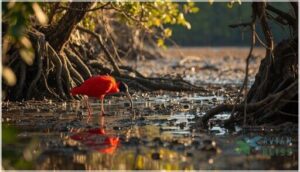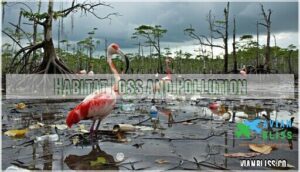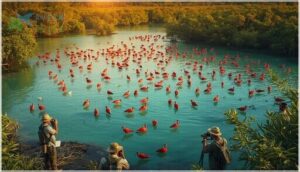This site is supported by our readers. We may earn a commission, at no cost to you, if you purchase through links.

Their specialized diet requires specific aquatic environments rich in crustaceans, small fish, and invertebrates that give them their brilliant red coloration. Without access to both saltwater and freshwater habitats, scarlet ibises can’t complete their complex feeding cycles or successfully raise their young.
Environmental factors like water levels, food availability, and suitable roosting trees directly determine whether colonies thrive or struggle to survive. The delicate balance of their ecosystem affects everything from reproduction to daily foraging success, making their ecosystem and habitat crucial for survival, and highlighting the importance of preserving their natural environment.
Table Of Contents
- Key Takeaways
- Environmental Importance
- Scarlet Ibis Survival Needs
- Habitat Requirements
- Environmental Threats
- Conservation Efforts
- Frequently Asked Questions (FAQs)
- What is the environment in which the scarlet ibis lives?
- What is the environment in which the ibis lives?
- What are the threats to the ibis?
- What kind of environment does The Scarlet Ibis need to survive?
- What helps scarlet ibis survive?
- What is the significance of nature in The Scarlet Ibis?
- How do scarlet ibises communicate with each other?
- What predators pose threats to scarlet ibis populations?
- How long do scarlet ibises typically live in the wild?
- Can scarlet ibises interbreed with other ibis species?
- Conclusion
Key Takeaways
- You’ll find scarlet ibis can’t survive without specialized coastal wetland environments – they’re completely dependent on mangrove forests, marshes, and mudflats for nesting sites, temperature regulation, and protection from predators.
- Their diet directly connects to environmental health – you need pristine aquatic ecosystems rich in crustaceans, small fish, and invertebrates that provide the carotenoids giving them their brilliant red coloration.
- Environmental threats pose immediate survival risks – you’re seeing habitat destruction, pollution, climate change, and invasive species competition directly impact their ability to breed successfully and maintain healthy populations.
- Conservation success depends on protecting entire ecosystems – you can’t save scarlet ibis without preserving their wetland habitats through restoration projects, pollution control, and coordinated protection efforts that maintain the delicate environmental balance they require.
Environmental Importance
You’ll quickly discover that scarlet ibises can’t survive without their specialized wetland environments, which provide everything from nesting materials to the crustaceans that create their signature red coloring.
These birds depend entirely on mangrove swamps, mudflats, and marshes for shelter, food, and protection from predators.
**Without pristine wetlands, scarlet ibises simply cannot exist – they’re utterly dependent on these fragile ecosystems.
Shelter and Nesting Sites
Security drives scarlet ibis survival through strategic nesting choices. You’ll find these magnificent birds selecting mangrove roots and colony protection sites with remarkable precision, ensuring shelter quality that’s literally life-or-death.
- Nesting trees positioned 1.5-12 meters above high tide prevent flooding
- Colony protection creates shared vigilance against predators through numbers
- Nesting materials form loose stick platforms supported by sturdy branches
- Wetland conservation preserves critical habitat restoration opportunities for species survival
The survival of scarlet ibis is heavily influenced by their ability to thrive in coastal wetlands.
Food Sources and Foraging Areas
When you explore scarlet ibis habitat, you’ll discover their prey diversity drives ecosystem balance.
These birds demonstrate remarkable foraging habits, targeting crustaceans, small fish, and insects in mangrove systems.
Their feeding behavior supports nutrient cycling while maintaining food chains.
Strategic habitat restoration guarantees wildlife preservation by protecting essential foraging areas that sustain biodiversity conservation efforts.
Protection and Water Access
Wetland environments provide scarlet ibis with essential protection from predators through dense mangrove cover and isolated nesting islands.
These coastal habitats guarantee reliable freshwater access for drinking and bathing, which maintains their vibrant plumage. Water quality directly affects their health, while habitat preservation protects these critical refuge areas.
Wetland conservation efforts maintain ecosystem balance, supporting both wildlife preservation and the species’ long-term survival needs.
Temperature Regulation
You’ll find scarlet ibis use thermal adaptation strategies to survive temperature changes in their tropical habitats.
These birds seek shade during peak heat to avoid heat stress, while dense mangrove canopies provide natural temperature control.
Climate shift patterns affect their feeding schedules, as changing weather patterns force behavioral adjustments.
Environmental conservation efforts focus on protecting these cooling refuges from habitat destruction, supporting climate change mitigation.
Scarlet Ibis Survival Needs
Your scarlet ibis faces three fundamental survival challenges that determine whether it’ll thrive or struggle in the wild. Understanding these needs helps explain why certain habitats become wildlife sanctuaries while others can’t support healthy populations.
Breeding Habits require specific conditions you mightn’t expect. These birds need undisturbed colonies where Flocking Dynamics create safety through numbers. When habitat destruction threatens nesting areas, entire populations can crash within a single season.
Migration Patterns aren’t random wandering – they’re survival strategies. Birds follow ancient routes between feeding and breeding grounds, timing movements with seasonal food availability. Feeding Behavior drives much of this movement, as scarlet ibis populations must locate rich crustacean beds that provide the carotenoids creating their signature red plumage.
Here’s what matters most for survival:
- Reliable food sources containing carotenoid-rich crustaceans and small fish
- Safe nesting territories protected from predators and human interference
- Clean water systems free from pollution that disrupts the food chain
Understanding bird adaptations for survival is essential in addressing the decline of scarlet ibis populations.
Environmental sustainability and wildlife protection efforts directly impact whether future generations will witness these magnificent birds in their natural habitat.
Habitat Requirements
Your understanding of scarlet ibis habitat needs determines whether you can predict their survival success in changing environments.
These birds require specific wetland conditions that provide both shelter and abundant food sources to maintain their populations.
Mangrove Forests and Marshes
Within mangrove ecosystems, you’ll discover nature’s perfect nursery for scarlet ibis colonies.
These coastal protection systems offer unmatched marsh biodiversity, supporting ibis nesting through water filtration and carbon sequestration processes that maintain environmental sustainability for endangered species.
These birds get their vibrant hue from carotenoid pigments found in their diet.
| Habitat Feature | Benefit to Ibis | Environmental Impact |
|---|---|---|
| Dense root systems | Secure nesting sites 1.5-12m above tide | Coastal erosion prevention |
| Brackish water zones | Rich crustacean prey sources | Natural water filtration |
| Canopy coverage | Temperature regulation for eggs | Carbon storage in biomass |
| Colony clustering | Predator protection through numbers | Biodiversity hotspot creation |
Freshwater Sources and Rice Fields
Beyond the mangroves, adult scarlet ibis regularly move to freshwater marshes and rice fields when feeding their chicks.
This shift guarantees maximal nutrition during the critical breeding period.
Rice field nutrients from agricultural runoff create rich feeding grounds, while freshwater availability supports diverse prey populations.
Marshland ecosystems provide essential water resources that directly impact ibis chick diet and overall reproductive success.
- Freshwater availability determines prey abundance and chick survival rates
- Rice field nutrients from agricultural runoff attract crustaceans and small fish
- Ibis chick diet relies heavily on protein-rich freshwater prey species
- Agricultural runoff creates nutrient-dense feeding environments when properly managed
- Marshland ecosystems serve as backup feeding areas during seasonal changes
Nesting Site Location and Adaptability
Throughout their range, these birds change nesting locations between seasons, showing remarkable adaptability to shifting environmental conditions.
Nest height varies from 1.5 to 12 meters above high tide, depending on available mangrove species and local flood patterns.
Site competition with invasive species threatens traditional colony relocation patterns, while climate change alters nest materials availability and coastal ecosystems stability, impacting bird conservation efforts.
Colony Behavior and Predator Protection
You’ll find safety in numbers when scarlet ibis gather in colonies.
Nesting Density creates natural Coordinated Defense against threats, with multiple birds alerting others to danger.
This Predator Avoidance strategy boosts Chick Survival rates substantially.
Colony Adaptability allows groups to relocate when needed, supporting bird conservation goals.
These wildlife conservation behaviors demonstrate effective ecosystem management, protecting biodiversity through collective action rather than individual conservation efforts.
Effective predator control methods are vital for maintaining healthy bird populations and habitats.
Environmental Threats
You’ll discover that environmental threats pose serious challenges to scarlet ibis populations across their range.
These dangers directly impact their ability to find food, establish safe nesting sites, and maintain healthy breeding colonies.
Habitat Loss and Pollution
You’re witnessing a devastating chain reaction when toxic waste and chemical runoff poison scarlet ibis habitats.
Deforestation strips away protective mangrove forests, while water pollution contaminates feeding grounds.
Soil erosion follows, destroying nesting areas completely, and these environmental conservation efforts face mounting challenges as pollution threatens biodiversity and wildlife conservation becomes increasingly urgent for habitat preservation.
Climate Change and Temperature Fluctuations
Rising temperatures trigger breeding cycle disruptions, shifting peak nesting months and reducing chick survival rates.
Climate change alters weather patterns and causes sea level rise through thermal expansion.
You’ll notice scarlet ibis colonies abandoning traditional sites as climate trends reshape their wetland habitats.
Environmental conservation efforts must address these climate shifts to maintain ecological balance and guarantee species preservation, which is crucial for maintaining ecological balance.
Invasive Species and Competition
You’ll encounter invasive species competing directly with scarlet ibises for prime nesting sites and food resources.
Looking at this content about scarlet ibis conservation, here’s an engaging blockquote that captures the competitive threat:
**Invasive species steal prime real estate from scarlet ibises, forcing these vibrant birds into survival mode.
Species invasion creates competitive dynamics where non-native birds often outcompete ibises, leading to native displacement.
This ecosystem imbalance triggers biodiversity loss as invasive species dominate mangrove territories.
Such environmental conservation challenges require urgent species preservation efforts to maintain ecological balance and prevent further biodiversity loss from these climate change effects on ecosystems.
Understanding the bird conservation status is essential for addressing these environmental threats effectively.
Human Disturbances and Poaching
Human activities pose serious threats to scarlet ibis populations through direct and indirect interference.
Tourism disrupts breeding colonies, while poaching for feathers reduces adult populations. Wildlife trafficking targets both eggs and live birds for illegal trade.
Key Human Threats:
- Habitat Destruction from coastal development destroys nesting sites and feeding areas
- Wildlife Trafficking removes breeding adults and eggs from wild populations
- Poaching Effects include reduced reproductive success and colony abandonment
Conservation Efforts focus on environmental protection through restricted access zones and anti-poaching patrols.
Environmental sustainability requires balancing human needs with wildlife research priorities in conservation biology programs.
Conservation Efforts
You’ll discover that protecting scarlet ibis populations requires coordinated conservation strategies targeting their wetland habitats and breeding colonies.
Scientists work alongside local communities to monitor population trends while implementing habitat restoration projects that guarantee these vibrant birds can thrive for future generations, which is crucial for their conservation.
Habitat Protection and Restoration
Protected areas serve as sanctuaries where scarlet ibis populations can recover and thrive.
Wetland conservation programs restore damaged mangrove forests while ecosystem management maintains sustainable water levels.
You’ll find habitat restoration projects removing invasive plants and replanting native vegetation.
Environmental sustainability initiatives protect breeding grounds from development pressures.
Effective wetland restoration techniques are vital for maintaining healthy ecosystems.
| Protection Strategy | Implementation Method |
|---|---|
| Reserve Establishment | Legal designation of critical wetlands |
| Mangrove Restoration | Replanting native trees in degraded areas |
| Water Quality Control | Pollution monitoring and waste reduction |
Wildlife preservation efforts focus on maintaining the delicate balance these birds need.
Environmental protection laws restrict harmful activities near nesting sites, while habitat preservation programs guarantee long-term ecosystem services remain intact.
Ecological conservation work helps prevent biodiversity loss through targeted restoration efforts.
Population Monitoring and Threat Identification
You can’t protect what you don’t measure.
Point count surveys and mist-netting during breeding season provide baseline Population Trends data through systematic Habitat Tracking methods.
Species Surveillance techniques like aerial surveys at 300-meter altitude help assess colony sizes and spatial distribution.
Threat Analysis combines direct observation with market surveys to identify hunting pressures and pollution impacts, enabling targeted Conservation Strategies for environmental protection.
Captive Breeding Programs and Education
Beyond tracking populations, you’ll find captive breeding programs serve as genetic insurance policies for scarlet ibis conservation.
These Wildlife Management initiatives combine Avian Research with hands-on Breeding Techniques to maintain healthy populations outside their natural habitats.
Here are four ways these programs protect scarlet ibis:
- Genetic diversity preservation – Scientists maintain breeding records to prevent inbreeding and preserve essential genetic variations
- Population backup systems – Captive colonies provide safety nets when wild populations face environmental disasters or habitat destruction
- Research opportunities – Controlled environments allow researchers to study breeding behaviors, nutrition needs, and disease prevention strategies
- Educational ambassadors – Captive birds in zoos and wildlife centers inspire Conservation Education and Environmental Awareness among millions of visitors annually
These ecological conservation efforts represent environmental sustainability research at its finest, combining environmental science with practical conservation strategies for ecological preservation.
Reducing Pollution and Mitigating Climate Change
Climate action starts with you – controlling pollution protects wetland habitats where Scarlet Ibis thrive.
Sustainable practices like reducing carbon emissions and supporting green initiatives directly combat climate change threats.
Eco-friendly pollution control measures preserve mangrove breeding sites, while environmental protection policies guarantee water quality remains suitable for foraging success.
Effective temperature management using climate control systems can also help maintain a stable ecosystem for the Scarlet Ibis, through sustainable practices and environmental protection.
Frequently Asked Questions (FAQs)
What is the environment in which the scarlet ibis lives?
Scarlet ibis thrive in tropical wetlands, mangrove swamps, mudflats, and shallow waters across South America and Caribbean regions.
You’ll find them congregating in dense marshes and mangrove islands that offer protection and abundant crustaceans, fish, and insects.
What is the environment in which the ibis lives?
Ironically, you’d think tropical birds need paradise, but ibises thrive in challenging wetlands.
These adaptable birds inhabit mangrove swamps, mudflats, shallow lakes, and coastal marshes across South America and the Caribbean, where dense vegetation provides protection.
What are the threats to the ibis?
You’ll find major threats include habitat loss from development, pollution from toxic chemicals, hunting pressure, and competition with invasive species for nesting sites, all jeopardizing their survival.
What kind of environment does The Scarlet Ibis need to survive?
You’ll need tropical wetlands with dense mangroves and marshes.
These environments provide protected nesting sites, abundant crustaceans and fish for food, and shallow waters for foraging.
Without these specific wetland habitats, scarlet ibis populations can’t survive.
What helps scarlet ibis survive?
You’ll find that diverse wetland habitats with rich food sources keep these birds thriving. Dense mangroves provide nesting sites and protection, while crustaceans supply essential carotenoids for their vibrant coloration.
What is the significance of nature in The Scarlet Ibis?
Nature functions as both a powerful literary symbol and the central force shaping characters’ destinies in "The Scarlet Ibis."
You’ll discover how Hurst uses natural elements to mirror emotional states and foreshadow tragic outcomes throughout the narrative.
How do scarlet ibises communicate with each other?
You’ll observe scarlet ibises using various vocalizations including harsh croaks, grunts, and honking calls for territorial defense, mate attraction, and flock coordination during feeding and flight formations.
What predators pose threats to scarlet ibis populations?
You’ll encounter several predators that threaten scarlet ibis populations throughout their wetland habitats.
Hawks, eagles, and owls attack from above, while snakes, caimans, and jaguars hunt from water and land, targeting eggs, chicks, and adults alike, which poses a significant threat to the populations.
How long do scarlet ibises typically live in the wild?
Scarlet ibis adults reach about 16 years in wild environments, but can thrive up to 20 years with proper care.
Their lifespan increases substantially under managed conditions, with some exceptional individuals living over three decades.
Can scarlet ibises interbreed with other ibis species?
Yes, you’ll find that scarlet ibises can absolutely interbreed with other ibis species.
White ibises are their most common breeding partners, creating stunning pink-colored hybrid offspring that display intermediate characteristics between both parent species.
Conclusion
Drastically different environments create vastly different outcomes for scarlet ibis populations, yet you’ll find these birds thrive only when specific conditions align perfectly.
Understanding how the environment is important to the scarlet ibis survival reveals their complete dependence on coastal ecosystems.
You can’t separate their vibrant existence from mangrove forests, clean waterways, and abundant food sources.
Their survival hinges on maintaining these delicate environmental balances through dedicated conservation efforts and habitat protection.
- https://m.espacepourlavie.ca/en/biodome-fauna/scarlet-ibis
- https://www.discourseblog.com/p/bird-of-the-week-scarlet-ibis
- https://sta.uwi.edu/fst/lifesciences/sites/default/files/lifesciences/documents/ogatt/Eudocimus_ruber%20-%20Scarlet%20Ibis.pdf
- https://animaldiversity.org/accounts/Eudocimus_ruber/
- https://pmc.ncbi.nlm.nih.gov/articles/PMC11240375/














